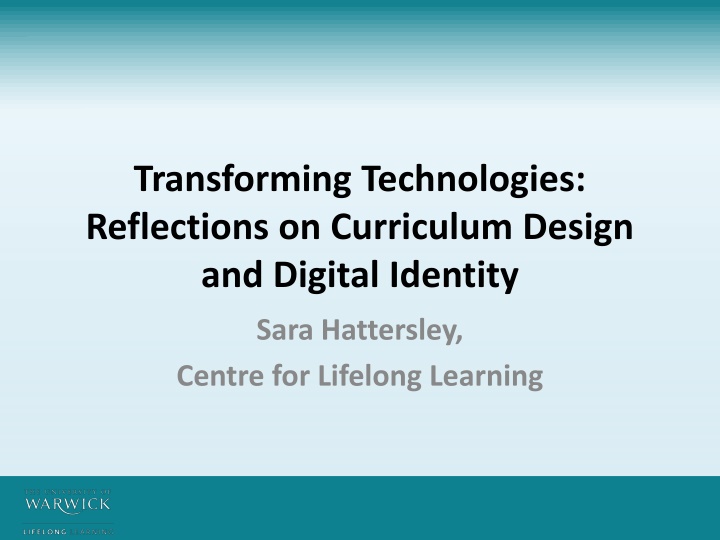
Reflective Insights on Transforming Technologies for Curriculum Design and Digital Identity
Explore "Transforming Technologies: Teaching and Learning in the Digital Age" course focusing on critical analysis, digital self, curriculum design, social media, mobile learning, and more. Unlock the essence of curriculum design through reflective practice and technology trends in education.
Download Presentation

Please find below an Image/Link to download the presentation.
The content on the website is provided AS IS for your information and personal use only. It may not be sold, licensed, or shared on other websites without obtaining consent from the author. If you encounter any issues during the download, it is possible that the publisher has removed the file from their server.
You are allowed to download the files provided on this website for personal or commercial use, subject to the condition that they are used lawfully. All files are the property of their respective owners.
The content on the website is provided AS IS for your information and personal use only. It may not be sold, licensed, or shared on other websites without obtaining consent from the author.
E N D
Presentation Transcript
Transforming Technologies: Reflections on Curriculum Design and Digital Identity Sara Hattersley, Centre for Lifelong Learning
About the course Transforming Technologies: Teaching and Learning in the Digital Age 20 credit PG Award 10 weeks, thematic approach (face-to-face + blended and mini MOOC approach). Part of new CLL flexible Masters route. Supported by Moodle (students also using Mahara).
Course overview Course Content Critical analysis Reflective practice Technology Trends The Digital Self Assistive Technology Curriculum Design Social Media Collaborative Approaches online Classroom interventions that really work E-Assessment Mobile learning and BYOD Technology futures
Explorations in Eytmology Curriculum= (Latin) a race or the course of a race , deriving from the term currere, to run/to proceed . Learning = (old English) leomian learn also (German) lore . Pedagogy= (Greek) to lead the child Technology = (Greek) techne art, skills, cunning of hand and logio/lego I speak Source: Wikipedia (accessed 28/04/15) https://en.wikipedia.org/wiki/
Bringing it all together. Leading students, using skill, art and cunning, which you articulate, to run and proceed in the learning race.
2. Navigating Wikipedia 1. Accessing Wikipedia I know this is a quick way to find stuff I just Google Wikipedia it ll be the top link I know the interface I know how to search and move through the pages. I m skimming for the eytmology of the terms it ll be somewhere near the top. Inherent knowledge I know about the issues surrounding Wikipedia; I understand Darwikianism and this helps me make my digital choice. 3. Retrieving information 4. Re-presenting information I ll cut and paste the bits I want into Word for now a sort of notepad (it happens to be open). I ll play about with the text and then re-present it in a slide in a better way (note to self- reference the source properly!)
Ways to make the curriculum explicit Sharing and reflecting on key documentation (e.g. course proposal and approval records, lesson plans) Explaining the relationship between learning and teaching activities, and assessment. Sharing the rationale for choice of approach, in particular, technology employed. Inviting students to be contributors to an evolving curriculum.
Source: Curriculum Theory and Practice http://infed.org/mobi/curriculum-theory-and- practice/
Modelling your thinking Explanatory artefacts videos, podcasts, infographics, mindmaps. Sharing your story exposing your own digital literacies and practices (e.g. how I go about approaching a new tool; how I use a tool for a set purpose). Unpicking and critically analysing tools, pedagogically, and evaluating choices.
Moodle quiz: conscientious design Pre-design thinking What are you hoping to test? Which question type might work? Why? What are the pros, cons and likely outcomes, pedagogically, of the choice of quiz and the settings you have created? What is the impact in terms of learner time and tutor (marking) time? What skills are needed by the learner? During and post-design Build the quiz and reflect on the process. Does it do what you want it to do? Test the quiz How easy is it to see the results? What do these results tell you/not tell you? What might you change?
Activities that promote student agency in a VLE Varied administrative and editing permissions Shared glossary of terms, repository or other space for sharing artefacts and notes. Resource or artefact creation for a key purpose. Reflections/discussion in a group blog or forum Ill-structured problems, using a wiki Peer assessed work/paired collaborations Profile information and settings Stepping out into an alternative space
Activities that promote engagement and persistence Notifications and alerts on forum entries, blogs and wikis. Work timelines, checklists and management Clear navigation and instructions Task-based, inter-dependent, incremental activities. Dialogue and feedback (tutor and/or peers). Source: TAP http://mahara.warwick.ac.uk/view/view.php?id=14563
Digital identity and Digital Literacy Literacies Identities Practices Events Domains Beetham and Sharpe (2010) Source: TAP (Amber Thomas) http://mahara.warwick.ac.uk/view/view.php?id=36138
Digital domains, tools and practices Digital practices are often well-established and driven by use of preferred tools and domains. Digital practices can also emerge from chance encounters or contrived routes . Digital domains and practices can overlap and change in their importance, over time. Social media e.g. Facebook=social; Twitter=professional Devices e.g. Phone=most things; iPad=classroom work, document annotation, sharing; laptop last resort! Tools e.g. Tools I really like (Mahara) V tools I dislike (Prezi)
Using student digital practices and literacies Working with them using spaces and tools that are compatible to students and their own devices supporting digital literacies Working outside of them using spaces and tools that are unknown to students ( learning in disequilibrium Piaget) extending digital repertoire
Discussion How far is a more explicit curriculum a more desirable curriculum? Or is it better to be artful and cunning ? What are the best ways to give students agency in the curriculum design process? Do they want to do it? What is the value of understanding our own and students digital literacies?
